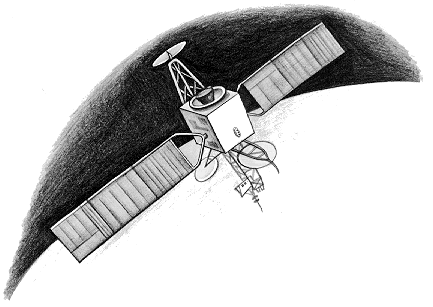
.
communications satellite
artificialsatellitesatellite, artificial,
object constructed by humans and placed in orbit around the earth or other celestial body (see also space probe). The satellite is lifted from the earth’s surface by a rocket and, once placed in orbit, maintains its motion without further rocket propulsion.
…..Click the link for more information. that functions as part of a global radio-communications network.Echo 1,the first communications satellite, launched in 1960, was an instrumented inflatable sphere that passively reflected radio signals back to earth. Later satellites carried with them electronic devices for receiving, amplifying, and rebroadcasting signals to earth.Relay 1,launched in 1962 by theNational Aeronautics and Space AdministrationNational Aeronautics and Space Administration
(NASA), civilian agency of the U.S. federal government with the mission of conducting research and developing operational programs in the areas of space exploration, artificial satellites (see satellite, artificial), rocketry, and
…..Click the link for more information. (NASA), was the basis forTelstar 1,a commercially sponsored experimental satellite. Geosynchronous orbits (in which the satellite remains over a single spot on the earth’s surface) were first used by NASA’s Syncom series andEarly Bird(later renamedIntelsat 1), the world’s first commercial communications satellite.
In 1962, the U.S. Congress passed the Communications Satellite Act, which led to the creation of the Communications Satellite CorporationCommunications Satellite Corporation
(Comsat), organization incorporated (1962) by an act of Congress to establish a commercial system of international communications using artificial satellites. Although government sponsored, it was financed by a public stock issue.
….. Click the link for more information. (Comsat). Agencies from 17 other countries joined Comsat in 1964 in forming the International Telecommunications Satellite Consortium (Intelsat) for the purpose of establishing a global commercial communications network. Renamed the International Telecommunications Satellite Organization (ITSO) in 1974, the organization transferred its satellite network to a private corporation, Intelsat, Ltd., in 2001. Intelsat now operates network of more than 50 satellites to provide global telecommunications. It has orbited several series of Intelsat satellites. ITSO continues to oversee the public service obligations of Intelsat.
Inmarsat was established in 1979 to serve the maritime industry by developing satellite communications for ship management and distress and safety applications. Inmarsat was originally an intergovernmental organization called the International Maritime Satellite Organization but later changed its name to the International Mobile Satellite Organization to reflect its expansion into land, mobile, and aeronautical communications. In 1999 its telecommunications operations became a private company as Inmarsat, and the International Mobile Satellite Organization became responsible for overseeing Inmarsat’s public service obligations. Inmarsat’s users now include thousands of people who live or work in remote areas without reliable terrestrial networks. Inmarsat presently has more than ten satellites in geosynchronous orbits.
In addition to the Intelsat and Inmarsat satellites, many others are in orbit, some managed by private companies and others by government-owned operators. These are used by individual countries, organizations, and commercial ventures for internal communications or for business or military use. A new generation of satellites, called direct-broadcast satellites, transmits directly to small domestic antennas to provide such services as cablelike television programming.
Bibliography
See G. D. Gordon, Principles of Communications Satellites (1993); D. H. Martin, Communications Satellites, 1958–1995 (1996); B. G. Evans, ed., Satellite Communication Systems (3d ed. 1999).
Communications Satellite
an artificial satellite used as an active or passive repeater in communications between ground stations located beyond the limits of line of sight. In the period 1965–75, communications satellites in various types of orbits were employed. The Soviet satellite Molniia IS and the American Intelsat series were put into stationary orbits. The Soviet series Molniia 1, Molniia 2, and Molniia 3 and the American Syncom series were put into elliptical synchronous orbits. The American Telstar and Echo series were put into circular, nonstationary orbits of medium or low altitude. (SeeSPACE COMMUNICATIONS and MOLNIIA.)
communications satellite
[kə‚myü·nə′kā·shənz ′sad·ə‚līt](aerospace engineering)
An orbiting, artificial earth satellite that relays radio, television, and other signals between ground terminal stations thousands of miles apart. Also known as radio relay satellite; relay satellite.
communications satellite
A radio relay station in orbit above the earth that receives, amplifies and redirects analog and digital signals contained within a carrier frequency. Based on their distance from the earth, there are three categories: GEO, LEO and MEO.
Geostationary (GEO) satellites are in orbit 22,282 miles above the earth. Because they rotate with the earth, they appear motionless to an observer on the ground. The GEO downlink to earth can be localized into small areas or cover as much as a third of the globe’s surface. Low-earth orbit (LEO) and medium-earth orbit (MEO) satellites are much closer to the ground, and they revolve around the planet. See GEO, LEO and MEO.
Fixed and Mobile Satellite Services (FSS/MSS)
Delivery from a communications satellite may be to stationary terminals such as rooftop dishes (see FSS) or to mobile terminals in cars, planes and ships (see MSS). See satellite Internet, satellite frequency bands and bent pipe architecture.
 |
| Communications Satellite |
|---|
| There are hundreds of commercial communications satellites in orbit providing private channels between business and government facilities as well as access to the Internet for the general public (see satellite Internet). |

